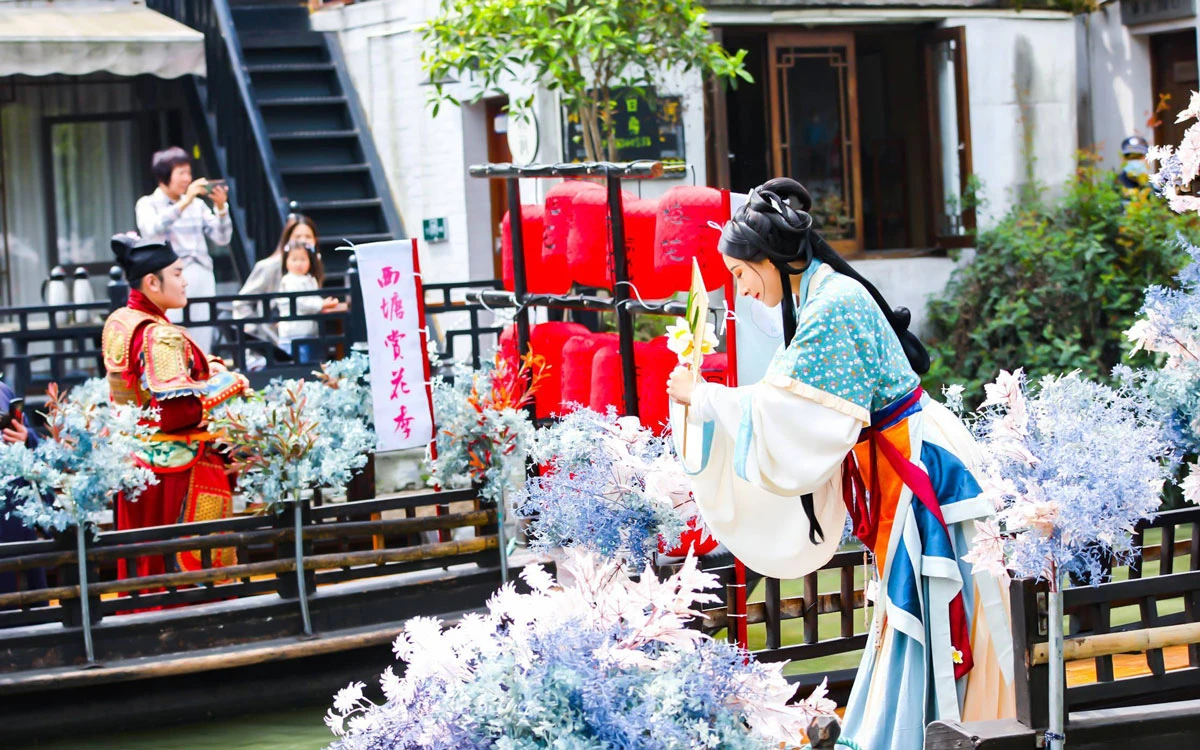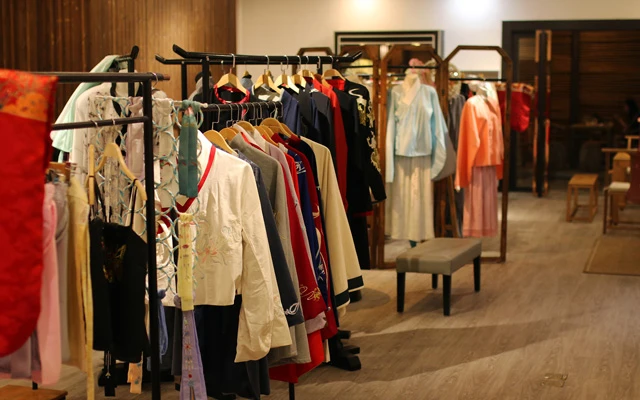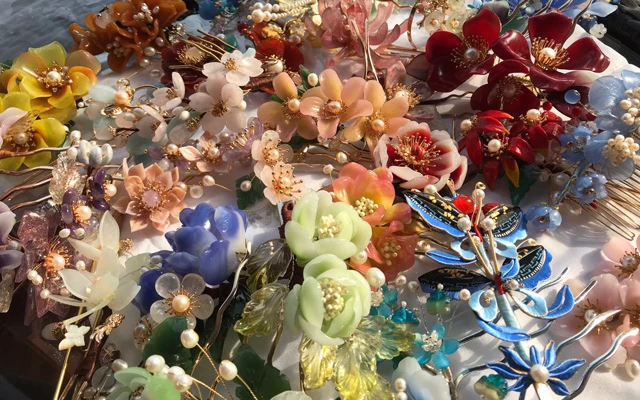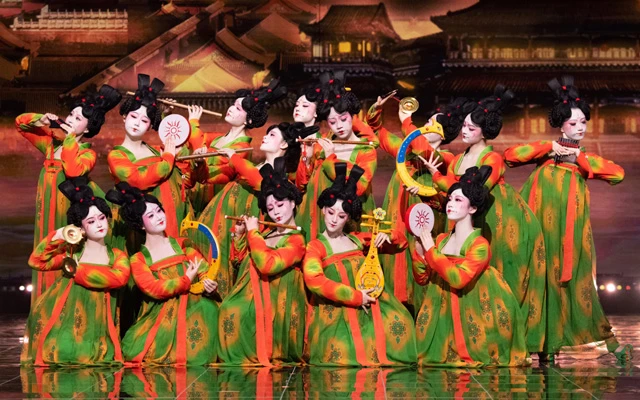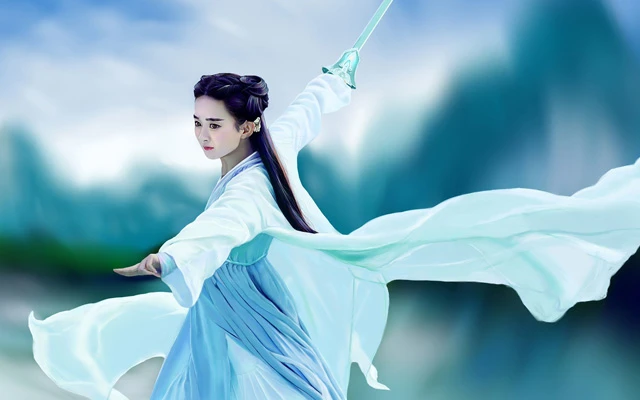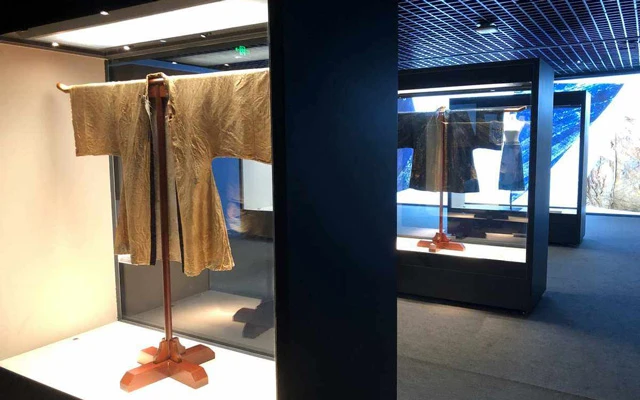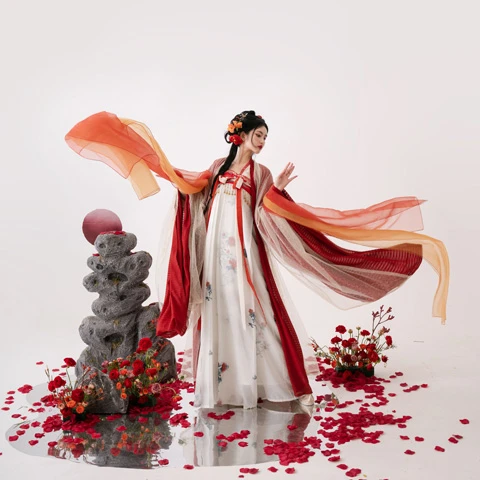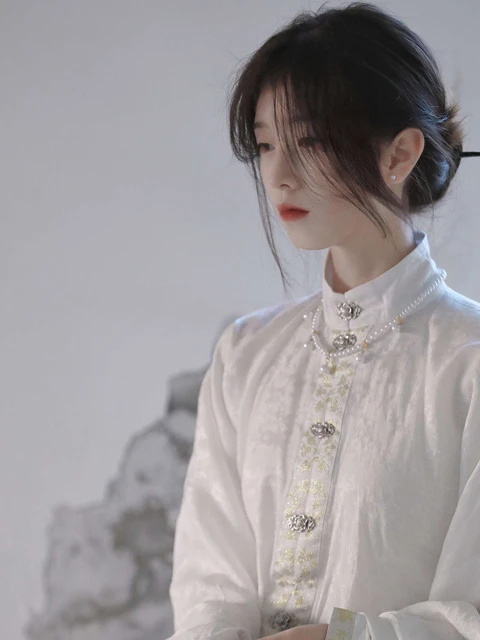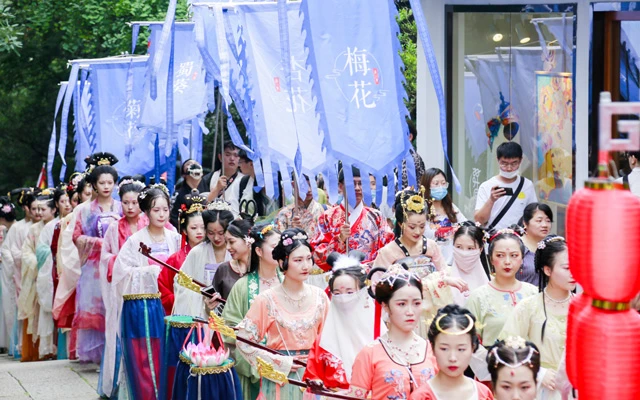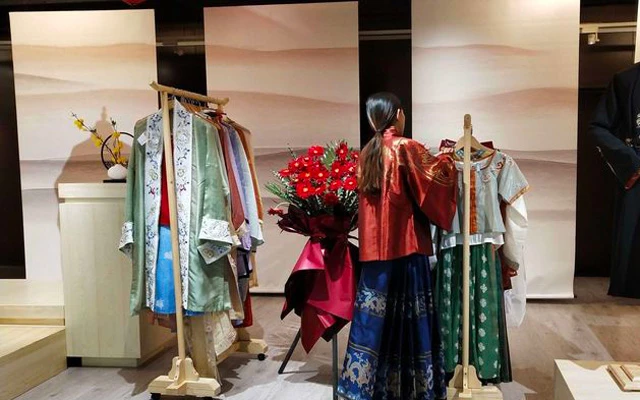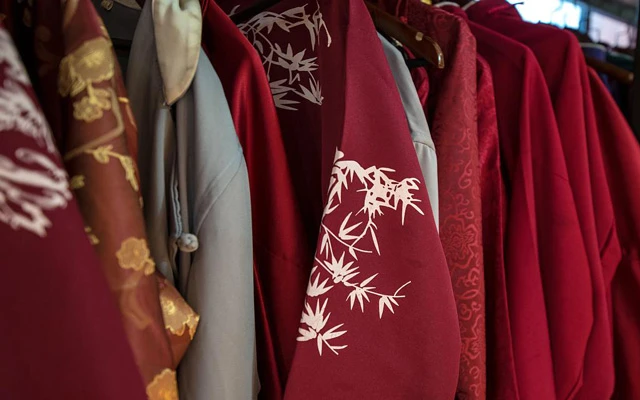An increasing number of young people are beginning to experiment with wearing hanfu, these clothing styles, which were widely used in different historical dynasties in ancient China, are now being reintegrated into contemporary life and have become an important part of youth culture.
The Origin of Hanfu Culture: From Niche to Popular
Typically, the origin of the modern Hanfu culture is traced back to 2003. On November 22nd of that year, a power worker named Wang Letian from Zhengzhou, Henan, walked into a downtown commercial street wearing hanfu. This event was reported by Singapore's Lianhe Zaobao, making Wang Letian the first modern Chinese person wearing hanfu to appear in public.
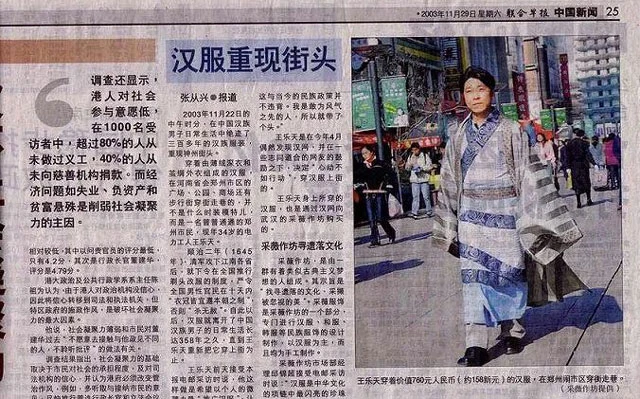
Wang Letian was introduced to hanfu culture through forums Han Wang, and around 2003, the first hanfu enthusiasts gathered around Han Wang and other online hanfu forums, gradually forming the Hanfu circle. At the same time, some offline Hanfu culture communities began to be established.
Around 2011, the subculture of adolescent internet culture rapidly developed. With the successive rise of the Lolita and the JK uniform fashion subculture, as well as the development of the cosplay community, hanfu has found its place among various clothing subcultures and has gained a similar community structure as the Lolita and JK uniform communities. At the same time, it has rapidly expanded its commercial scale.
In the cultural sphere, hanfu enthusiasts have established their own aesthetic preferences, while also demonstrating strong purchasing power in the economic sphere. In 2020, the number of Chinese hanfu enthusiasts reached 5.163 million, and the hanfu market size reached 6.36 billion yuan, with a year-on-year growth rate of over 40%. In 2021, the market size is expected to reach close to 1 billion yuan.
In the second decade of the 21st century, the era of forums is gradually coming to an end in China. hanfu enthusiasts, who refer to each other as "Tong Pao (同袍)" or "Pao Zi (袍子)," often gather on social media and content platforms to share information about new and second-hand hanfu products, exchange the latest research on hanfu design, and discuss the latest developments.
In addition to sellers and buyers of hanfu, there are also hanfu handicraft enthusiasts who design and make hanfu for themselves, share hanfu-making techniques, and hanfu enthusiasts who take photos and videos in hanfu, and conduct reviews of hanfu workmanship and wearing experience. There are also bloggers who collect, summarize, and popularize research results related to hanfu design, hanfu photographers, and hanfu hairpin makers. These different roles and identities of hanfu enthusiasts come together to form a rich and colorful subculture.
Around 2018, hanfu culture entered the mainstream cultural spotlight. Activities such as the Xitang Hanfu Culture Week and Chinese Hua Fu Day allowed outsiders to start paying attention to the aesthetic style and traditional dress culture inherent in hanfu. Riding the wave of the rise of Chinese culture and national trend, hanfu has gained a broader space for development.
In the Henan TV Lantern Festival Gala, the female dancers dressed in Tang Dynasty Qixiong Dress were like Tang Dynasty women walking out of murals, winning the recognition and love of audiences nationwide. The costumes in "Tang Palace Night Feast" did not follow the dress style of historical costume cdramas and fantasy dramas, but instead emphasized restoration, clearly influenced by the restoration style aesthetic of traditional color and pattern in hanfu culture.
In the first decade of the 21st century, hanfu was often seen as strange clothing. Many senior hanfu enthusiasts have mentioned in their self-descriptions how they summoned up the courage to wear hanfu out and how they were embarrassedly asked by passers-by, "Are you wearing a kimono/hanbok/cosplay costume?" Today, wearing hanfu out is no longer novel, especially for young people born in the 2000s, wearing hanfu is becoming a new trend.
The continued rise of traditional Chinese culture has nourished the development of a group of ancient-style subcultures, including hanfu subculture and ancient-style music. The general interest in traditional Chinese culture has stimulated the re-discovery of traditional aesthetic styles, and hanfu, which combines visual elements such as form, color, and pattern, is undoubtedly an important site and concentrated display of this aesthetic style rediscovery.
Tracing Tradition and Integrating into the Present
Hanfu culture is a rediscovery of traditional clothing culture and ethnic aesthetics, as well as a new era subculture of clothing formed under the interaction of global popular culture. It combines traditional beauty with modernity, rooted in the local culture while maintaining openness to global culture.
Undoubtedly, "Hanfu" is a contemporary concept that has only emerged and developed in the past 20 years. According to the general definition in the hanfu circle, hanfu refers to the clothing worn by the Chinese people from the pre-Qin period to the Ming dynasty. However, it is difficult to determine whether a piece of clothing belongs to hanfu based solely on this definition.
Through a series of debates within the hanfu circle, including the whether Xianxia styles costume belong to the category of hanfu, whether the improved versions of hanfu and han elements belong to hanfu, a relatively clear system for defining Hanfu has been established. In the early days, hanfu was often influenced by costume dramas, especially martial arts and fairy tales, leading to an early hanfu style characterized by a cross-collar, a waistband, and large sleeves, commonly known as "Wei Jin style." At this time, the hanfu circle did not have a clear sense of form, and the production of hanfu often pursued artistic conception and form rather than the structure of clothing. It was not until around 2017 that form truly became a keyword in the hanfu circle.
Hanfu enthusiasts collected and organized a large amount of unearthed cultural relics, research papers, and monographs on ancient Chinese clothing, summarized the structural characteristics of common clothing worn by the Chinese people throughout history, which is the form of hanfu. Due to the fact that murals, pottery figurines, and other cultural relics can only provide the external features of clothing and not the structural features, the most rigorous hanfu forms are based solely on clothing relics.
Therefore, in hanfu stores, we can often see phrases such as "Imitation of Huang Sheng Tomb Song Mo," "Ma Wang Dui Zhiju/Quju," "Changgan Temple Bei Zi," "Imitation of Confucian Mansion Flower and Bird Skirt," etc., which refer to hanfu products made according to the structure and data of relics. On the other hand, forms that may exist in theory but lack sufficient relic support are called "uncertain forms," while clothing structures that are completely impossible to have appeared in ancient China are expelled from the category of hanfu and are commonly referred to as Han elements.
According to the strict standards of the hanfu form, the Quju worn by Wang Letian in 2003 and those unearthed from the Mawangdui Han Tomb are not consistent in structure and should be classified as Han elements costume. However, this type of Quju was popular for a time around 2015.
Another famous case regarding hanfu forms is the so-called two-piece ruqun. In many Tang Dynasty murals, female figures wearing chest-high skirts reveal a portion of their inner clothing at the armpit skirt hem. As a result, some merchants have produced a two-piece ruqun that appears more consistent with the clothing features in the murals. However, according to the mainstream conclusion in the hanfu circle, from existing data, the two-piece skirt structure never appeared in ancient China.
Based on the compilation of a large number of literary materials, the hanfu circle has gradually formed a set of knowledge about the dominant hanfu forms and wearing methods in various dynasties. For example, when it comes to Jin Dynasty, the first thing that comes to mind is probably the upper garment with a Yao Lan (腰襕). When it comes to Tang Dynasty, people often think of the short shirt and long skirt that cover the chest. The representative of Ming Dynasty is the standing collar shirt and Mamian skirt, and so on.
Based on this, the hanfu circle has summarized some basic characteristics of hanfu shared by all dynasties, such as flat cutting, one-piece skirt, the left lapel covers the right lapel, and loose-fitting with long sleeves. Of course, not all people in the hanfu circle agree with the form regulations on hanfu. There is always a debate about the limits of hanfu improvement. This debate has effectively stimulated the integration of hanfu and fashion, making it possible for hanfu to further integrate into daily life.
A group of hanfu lovers insists that the improvement of hanfu should be based on correct form, and on this basis, fashion fabrics and patterns should be used, the length of the skirt should be shortened, and accessories such as pockets, zippers, and hidden buttons should be added to make hanfu more convenient for daily wear. Especially for Ming Dynasty hanfu, with a standing collar and buttons, is closer to fashion, and after intentional daily design, it can almost seamlessly integrate into various modern life scenes, whether it is shopping or commuting to work.
Businesses that do not care about form, on the other hand, incorporate common elements of hanfu, such as crossed collars, Zimu buttons, Pipa sleeves, and cloud shoulders, into fashion design, bringing about the prosperity of han elements fashion design. The daily wear hanfu designs highlight both fashion and convenience. The restoration-style hanfu emphasizes traditional hanfu patterns, while the "ACG" style hanfu draws inspiration from other niche clothing cultures such as JK uniforms and Lolita, showcasing the inclusivity and openness of the hanfu subculture through its diverse styles and usage scenarios.
Tracing tradition and integrating into the present, the hanfu culture has always developed under the tension of these two goals. The creation of the concept of "hanfu" and the rediscovery of Chinese traditional clothing culture by the hanfu community is undoubtedly not a simple retro movement. Even in the case of restoration-style hanfu, it still reflects the reshaping of ancient culture by contemporary aesthetics and demands.
Hanfu Culture in Contemporary Life
Hanfu is not just clothing, but also a contemporary cultural and lifestyle choice for young people. As an internet-era subculture of youth clothing, the social and cultural activities of the hanfu community often unfold through online and offline interactions. Instant messaging tools provide hanfu enthusiasts with a more decentralized way of communicating, allowing everyone to become an equal participant in showcasing hanfu culture and sharing hanfu lifestyle experiences.
Strangers who have become acquainted through hanfu also share their daily life experiences within hanfu-related communities, which are closely linked to offline hanfu social activities. Hanfu enthusiasts from the same city or school can organize hanfu gatherings and other activities. The term "Ya Ji (雅集)" comes from ancient times, and its meaning in today's hanfu community is very flexible. Hanfu enthusiasts can gather together to play music, go for outings, or hold hanfu knowledge lectures, and all of these can be called "yaji". In short, small-scale hanfu gatherings can all be called "Ya Ji".
Larger-scale hanfu events often have commercial elements, borrowing the basic model from anime convention. For example, the well-established "Xitang Hanfu Cultural Week" is held in Xitang Ancient Town, Zhejiang Province from late October to early November each year. The event includes a hanfu market, hanfu performances, hanfu development forums, and more.
Most anime convention also accept applications for hanfu-related booths, and wearing hanfu to visit anime convention has become a regular activity for hanfu enthusiasts. At the 17th China International Anime Convention in Hangzhou, Zhejiang Province in 2021, a 77-year-old grandma wearing hanfu made a stunning appearance and became a hot topic, proving that love for hanfu knows no age.
As an emerging cultural industry, hanfu culture has also become a career choice for many young people. Many born in the 1990s and 2000s have transformed from hanfu enthusiasts to hanfu designers, hanfu store owners, hanfu photographers, and more, finding their own careers in the hanfu industry chain.
For example, hanfu designer Qian Qian, who majored in dance, started researching hanfu shapes and self-studying design at the age of 16 in order to wear her own designed hanfu. She achieved economic independence by designing hanfu in her freshman year. Practitioners in the hanfu industry often use the internet as their platform, accumulating contacts in cyberspace and discovering business opportunities in the hanfu culture's online community.
In addition to collecting hanfu information online, Qian Qian also joins some hanfu design and production groups exchange and learn from peers, and gradually accumulates popularity and customer sources by posting her design works in large hanfu exchange groups.
Whether hanfu is seen as a profession or a hobby, hanfu culture has deeply penetrated the culture, social life, and self-expression of contemporary young people, becoming an important way for them to create a sense of ritual in their lives, find like-minded people, and understand the beauty of tradition and traditional culture. Walking on the street wearing hanfu, nodding and smiling at strangers who also wear hanfu, passing by each other is a romantic journey through time and space.
